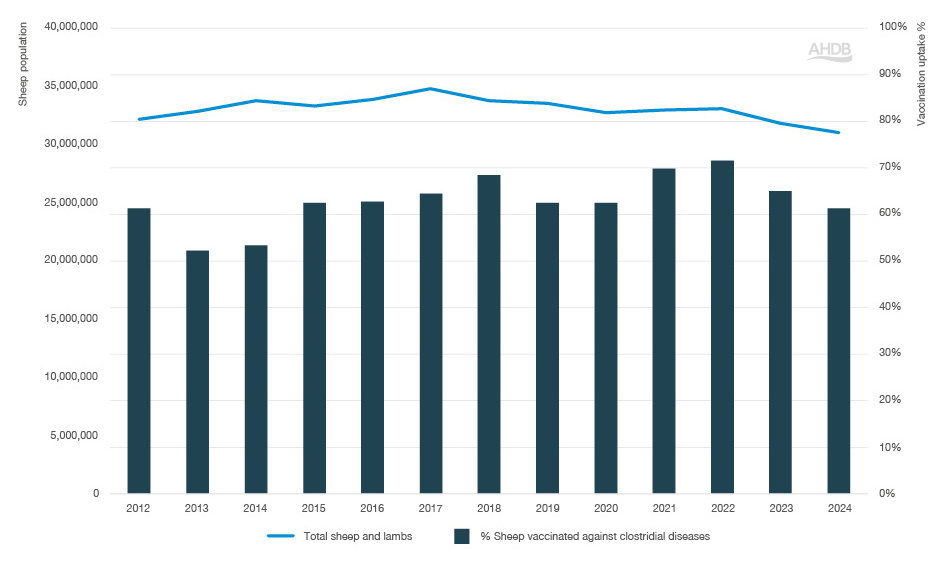- Home
- Knowledge library
- Clostridial vaccines in sheep
Clostridial vaccines in sheep
Clostridial vaccines are cheap and highly effective multivalent vaccines, but deaths caused by clostridial diseases remain high, resulting in considerable losses to the sheep industry.
Clostridial disease is a common cause of sudden death of sheep in the UK.
Clostridial bacteria live in the soil, produce toxins and cause disease when ingested or by entering wounds. With clostridial diseases, it is not the bacteria that cause disease but the toxins they produce.
Examples of clostridial diseases include pulpy kidney disease (Clostridium perfringens type D), lamb dysentery (C. perfringens type B), struck (C. perfringens type C), braxy (C. septicum), black disease (C. novyi), and botulism (C. botulinum).
Individual vaccine datasheets provide information on which bacteria each vaccine is effective against and contain instructions on correct administration.
Not all clostridial vaccines provide cover against all the clostridial bacteria.
A primary vaccination course is required followed by annual booster doses. If the dam has received a full primary vaccination course before pregnancy and receives a booster (check the products for timing) before parturition, she will provide her newborn lamb with passive immunity via her colostrum.
However, it is important to check datasheets as, for example, Ovivac P does not protect against lamb dysentery so other vaccines may be preferable for use during pregnancy to protect young lambs.
The following multivalent clostridial vaccines have been marketed in the UK:
- Bravoxin® is a multivalent clostridial vaccine for cattle and sheep
- Covexin 8 is a multivalent clostridial vaccine for cattle and sheep
- Covexin 10 is a multivalent clostridial vaccine for cattle and sheep
- Heptavac P Plus is a multivalent clostridial vaccine for sheep that can also aid in the control of pneumonic and systemic pasteurellosis
- Lambivac is a multivalent clostridial vaccine for sheep and pigs
- Ovivac P Plus is a multivalent clostridial vaccine for sheep that can also aid in the control of pneumonic and systemic pasteurellosis
Assumptions
Numerator
The number of doses of vaccine administered has been calculated by multiplying the number of packs sold by the number of doses per pack.
For Covexin 8, a higher dose is used as the first dose in the primary vaccination course.
It has been assumed that 20% of all doses of Covexin 8 are used in primary vaccination courses, and that half of these are administered at the higher dose level (i.e. it has been assumed that 10% of Covexin 8 doses used in sheep are 5 ml and the remainder are 2 ml).
Bravoxin and Covexin 8 are also licensed for use in cattle.
It has been assumed that 80% of the use of these vaccines is in sheep and the remainder in cattle. A small amount of clostridial vaccine is also used in pigs, but is not considered significant.
Denominator
The common industry recommendation is to vaccinate lambs with a primary course of clostridial vaccine, unless they are destined for slaughter before 12 weeks of age, or the dam was given a booster vaccine in late pregnancy.
It is recommended that all adult sheep should be given a primary course and an annual booster.
The total number of clostridial vaccine doses that would be required by the national UK flock has been estimated based on the assumption that all lambs in flocks in June receive two doses of clostridial vaccine and that the total breeding flock and all rams receive one annual booster vaccination.
Vaccination uptake
Clostridial vaccine uptake has fluctuated slightly since 2012, but the overall trend is an increase in estimated uptake.
However, in recent years, estimated uptake has dropped from 65% in 2023 to 61% in 2024; this is likely due to continued supply issues.
Figure 1. Percentage of sheep vaccinated against clostridial diseases


